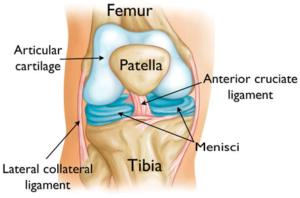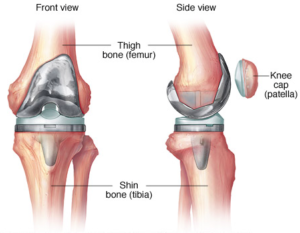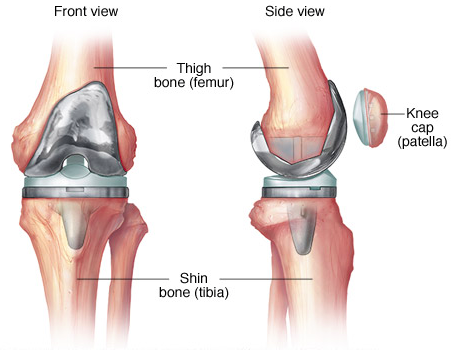Total knee replacement (TKR), also known as total knee arthroplasty (TKA), is an orthopedic surgical operation in which artificial implants are placed in a patient’s dysfunctional knee. The artificial parts in this type of joint reconstruction include metal and plastic that are meant to mimic the function of a healthy knee joint.
Knee Anatomy
A healthy knee joint is comprised of bones, cartilage, and ligaments. The bones of the knee joint include the femur (thigh bone) and tibia (shin bone). The ends of these two bones meet in the knee joint. The end of the tibia (shin) is flat and the end of the femur (thigh) is round. A cartilage structure, called the meniscus, sits on tibia to provide a cushion between the bones. Likewise, a cartilage structure, called articular cartilage, can be seen on the end of the femur, also providing a cushion between the bones.

The four ligaments in a healthy knee joint include the Anterior Cruciate Ligament (ACL), Posterior Cruciate Ligament (PCL), Medial Collateral Ligament (MCL), and Lateral Collateral Ligament (LCL). The LCL is on the outer side of the knee and the MCL is on the opposite side. The ACL and PCL are in the middle, between the tibia and femur. These ligaments provide stability so the knee can function properly while a person does things like walk, run, squat, and pivot. Without ligaments, the round femur sits on top of the flat tibia, which, as you can imagine, would be unstable.
What’s in a Total Knee Replacement
A total knee replacement procedure typically takes place when someone experiences chronic knee pain. Knee pain can arise after many years of active living, causing the cartilage in the knee to wear down. Damaged cartilage leads to no cushioning, which causes bone-on-bone interaction in the joint. Bone-on-bone interaction causes severe pain in the knee, especially when trying to participate in activities; even activities as simple as walking.

The important thing to remember about the components of a healthy knee (bones, cartilage, and ligaments) is that they provide structure and stability in order for a person to live a pain-free lifestyle. Any damage or hindrance to any of these knee structures can prevent a person from the life they want.
As mentioned previously, a reconstructed knee joint includes artificial parts made of metal and plastic. The artificial tibial (shin bone) component is a metal tray that sits on the end of the tibia. The artificial femoral (thigh bone) component is a metal “cap” that is placed on the end of the femur. The ends of the bones will be cut specifically so the metal parts can properly fit in place. The cartilage components of the knee will be replaced with a plastic piece between the two metal components. The new plastic piece will provide a cushioning. The ligaments of the knee joint may be removed, depending on the type of implant the patient receives. For more information about special characteristics of total knee replacement, read 7 Characteristics of Knee Replacement Products.
Someone may be a candidate for TKR if they struggle to live pain-free because of a dysfunctional knee. The candidate may find that pain is an obstacle when trying to complete activities such as walking, squatting, kneeling, and pivoting. If someone is hindered by their current knee function, they may be able to improve their quality of life after total knee replacement. Be sure to always consult a doctor when considering medical treatment, such as total knee replacement, to discuss specific knee implants, treatment, and rehab.
Sign up for the free newsletter and receive the 2017 Knee and Hip Replacement Price Report.
